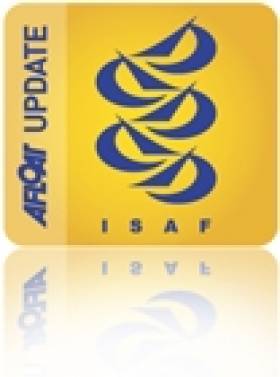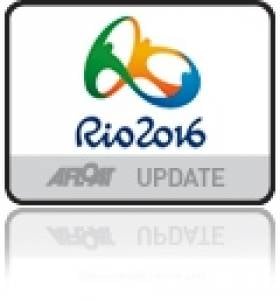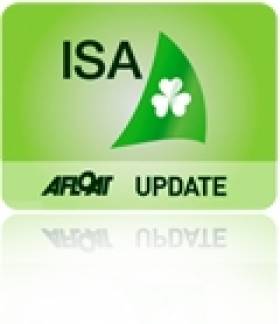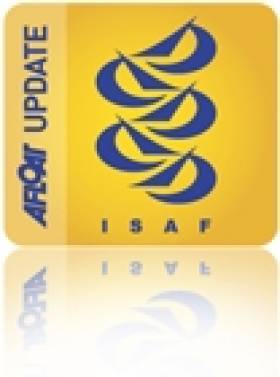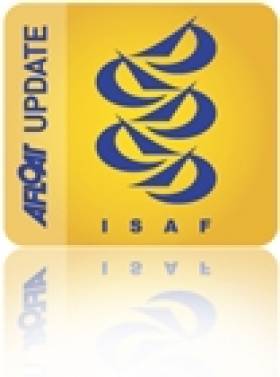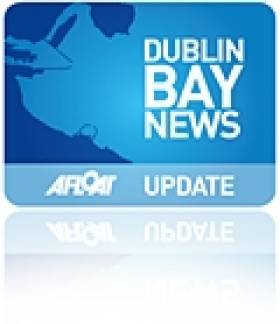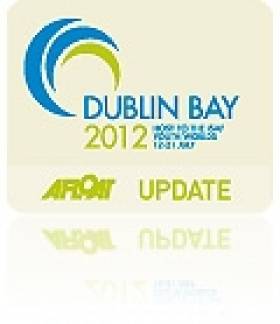Displaying items by tag: ISAF
New ISAF Council Announced in Dublin
#isaf – Ireland continues to be represented at the highest level in international sailing with The International Sailing Federation (ISAF) announcement of its new members of the ISAF Council, the final decision-making body of ISAF.
The new members of the ISAF Council were announced at the ISAF General Assembly in Dun Laoghaire, Ireland.
The Council is chaired by the ISAF President Carlo Croce (ITA) and also includes the seven Vice-Presidents, the Treasurer (non-voting) who is yet to be confirmed, 28 representatives of ISAF Member National Authorities (MNAs) and one representative each from the the athletes' commission, ISAF Classes, Offshore sailing and Women's sailing.
In addition, the ISAF Presidents of Honour, His Majesty King Harald V of Norway and His Majesty King Constantine, are entitled to attend and participate in Council meetings although they do not hold a vote. The new Council members will serve a four-year term up until the ISAF General Assembly in November 2016.
The new members of the ISAF Council are:
President and Chairman – elected by ISAF MNAs at 2012 ISAF General Assembly
Carlo Croce (ITA)
Vice-Presidents – elected by ISAF MNAs at 2012 ISAF General Assembly
George Andreadis (GRE)
Chris Atkins (GBR)
Adrienne Greenwood (NZL)
Nazli Imre (TUR)
Gary Jobson (USA)
Quanhai Li (CHN)
W Scott Perry (URU)
Treasurer (non-voting)
To be appointed in due course.
It is the responsibility of the ISAF Council to manage the business of the International Sailing Federation. Ultimately, policy decisions within ISAF, including any amendments to the ISAF Regulations, are subject to the approval of the Council.
The ISAF Committee members, who are appointed primarily because of their expertise in a particular area, of the ISAF Council are required to represent their national viewpoint. Through this mechanism the process of ISAF's decision-making reaches it climax at the ISAF Council meeting. Council members exercise their vote based on the recommendations provided the expert ISAF Committees, the views of the Member Nations they represent and the requirement to have regard to the interests of the sport worldwide.
The new Council met for the first time on the final day of the 2012 ISAF Annual Conference. Following on from this meeting, one of the first tasks of the Council will be to confirm the appointment of ISAF Committee Chairman, Vice-Chairman and Committee members for 2013-2016.
The new Executive Committee first met on 11 November 2012 in Dun Laoghaire.
Council Representatives – appointed by ISAF MNAs
Group A – United Kingdom and Ireland~
Dick Batt (GBR)
John Crebbin (IRL)
Group B – Central Europe
Rolf Bahr (GER)
Marijan Hanzekovic (CRO)
Group C – East Europe
Tomasz Chamera (POL)
Kamen Fillyov (BUL)
Group D – South Europe
Jean Pierre Champion (FRA)
Dorith Stierler (ISR)
Totos Theodosiou (CYP)
Group E – Iberian Peninsula
Rafa Gonzalez (ESP)
Group F – Low Countries
Rob Franken (NED)
Group G –North Europe
Stig Hvide Smith (NOR)
Kurt Lonnqvist (FIN)
Group H – Euro-Asian
Georgy Shayduko (RUS)
Group I – Africa and Middle-East
Khalifa M Al-Sewaidi (QAT)
Group J – East Asia
Karl C Kwok (HKG)
Takao Otani (JPN)
Group K – South and Central Asia
Loh Kok Hua (SIN)
Group L – South West Pacific
Jan Dawson (NZL)
David Tillett (AUS)
Group M – South and West South America
Pablo Masseroni (ARG)
Group N – Central and East South America
Harry Adler (BRA)
Group O – North South America, Central American and Caribbean
Cary Lee Byerley (ANT)
Hector Duval (DOM)
Group P – North America
Gary Bodie (USA)
Peter Hall (CAN)
Cory Sertl (USA)
Group Q – Africa – South of the Sahara
Ross Robson (RSA)
ISAF Classes Representative – appointed by the International Classes Committee
Jeff Martin (GBR)
Oceanic and Offshore Sailing Representative – the Chairman of the ISAF
To be appointed in due course.
Women's Sailing
To be appointed in due course.
Athletes' Commission
Ben Barger (USA)
Bitter Blow for Kites as Windsurfing is Reinstated in Olympics
#OLYMPICS - Windsurfing has been reinstated in the Olympic Games programme at the expense of new class kitesurfing after a vote by the International Sailing Federation (ISAF) yesterday, as Eurosport reports.
It had been expected that sailing's world governing body would reach a compromise of sorts at its annual general meeting in Dun Laoghaire by keeping both classes in the Rio Games in 2016.
The original decision to replace windsurfing with the new sport of kitesurfing back in May was considered a surprise move, but the ISAF has surprised again with its reversal of that decision.
Windsurfing's supporters were said to be "shell-shocked" by the original vote, and vowed to lobby the ISAF to overturn the decision in Dublin, for which they needed a two-thirds majority.
Israel's sailing head Yehuda Maayan told Reuters that delegates had likely been confused about the original vote because of language difficulties, noting that the Spanish delegate had voted for kiteboarding by mistake.
Among those expressing their disappointment at the about face was Virgin founder Richard Branson, who wrote on his blog that the ISAF had "have misled everybody and been very short-sighted in making this knee-jerk decision".
He added: "Their original decision was the right one and a brave one, although my own feeling is that there is room for both sports in the Olympics. If they had to drop anything it should have been one of the less exciting sailing races, which really don't capture the public's imagination."
The move is also a bitter blow for Irish kitesurfer Claudine Murphy, sister of Olympic star Annalise Murphy, who had been campaigning in the new class to make it a sister act at the Rio Games.
In other news from yesterday's ISAF AGM, new members of the ISAF Council have been announced.
Italy's Carlo Croce was elected president and chair of the council that also includes seven vice presidents: George Andreadis (Greece), Chris Atkins (UK), Adrienne Greenwood (New Zealand), Nazli Imre (Turkey), Gary Jobson (USA), Quanhai Li (China) and W Scott Perry (Uruguay).
Also on the council are a non-voting treasurer (yet to be confirmed), 28 representatives from member national authorities (MNAs) and individual representatives from the athletes' commission, the ISAF classes, offshore sailing and women's sailing. Sailing.org has full details on the new council HERE.
from ISAF
Kiteboards Out / Windsurfing Back In
Dun Laoghaire, Ireland: After three days of meetings, the ISAF Annual Conference drew to a close Saturday as the final decisions affecting the sport moving forward were made.
23 submissions relating to the events and equipment for Rio 2016 were received by ISAF in advance of the Conference. In accordance with the ISAF Regulations, before the detail of any of these particular submissions could be discussed, Council were required to vote on a motion to re-open the debate on the subject. The Regulations specify that 75% of members must agree to the motion.
The submissions were presented as six proposals and Council asked to vote on them in terms of the specific changes they proposed. The first proposal grouped. 26 Council members voted in favour and 12 were against.
Proposal 2, which featured Submission 063-12, related to Men's Kiteboarding, Women's Kiteboarding and 2nd One Person Dinghy - Finn. 14 Council members voted in favour and 23 were against and 1 abstained.
With 38 possible votes, the 75% requirement was not achieved on either proposal so the events and equipment as approved in May 2012 remain for Rio 2016.
However, at the ISAF General Assembly part of the business for the 106 Member National Authorities (MNAs) who were present was to review any regulations made or amended in any substantive way by Council since the last Ordinary Meeting which was in November 2011.
ISAF had been notified of three amendments proposed by MNAs which concerned the first two lines of Regulation 23.1.4 (Men's and Women's Kiteboarding).
As defined in the Articles of ISAF, decisions at the General Assembly shall be taken by a simple majority of votes of those present and entitled to vote. There were 114 possible voters, including the ISAF President and Vice-Presidents.
After a lengthy debate the MNAs approved the first proposal which reinstated Men's and Women's Boards - RS:X.
ISAF Regulation 23.1.4 now reads:
Men's Board - RS:X
Women's Board - RS:X
Men's One Person Dinghy - Laser
Women's One Person Dinghy - Laser Radial
Men's 2nd One Person Dinghy - Finn
Men's Skiff - 49er
Women's Skiff - 49erFX
Men's Two Person Dinghy - 470
Women's Two Person Dinghy - 470
Mixed Two Person Multihull - Nacra 17
sailing.org
Some Kite Flying for an Olympic Decision
#isaf – Kites or sailboards to be highlighted the most exciting form of sailing in the 2016 Olympics? If you're waiting for a clearcut answer from the continuing deliberations of the International Sailing Federation currently under way at their Annual Conference in Dun Laoghaire, then don't hold your breath.
Of all the world's capital cities, it is Dublin which is probably most aware of the growing impact of windsurfing and kite-surfing as hugely accessible forms of sailing which can take place off any beach. The greater city area is so well-endowed with miles of sand which can provide world class sport when the wind is up that, like it or not, we ordinary Dublin beach-walkers have become connoisseurs of the kiting versus sailboards controversy.
So although it may have discomfited many traditionally-minded national sailing establishments when sail-boarding became an Olympic sport, we Dubs were ahead of the posse. We were already looking to the next move. For we knew that, when surrounded by kitesurfers at choice venues like Dollymount Strand, sailboarders can seem like dowagers at a disco.
Thus with world sailing's sometimes embarrassing desire to appear hip, it was no surprise back in May when it was announced that, albeit by the narrowest of voting margins, kite-surfing would replace windsurfing at Rio in 2016. But while it may have been a definite decision, seems it wasn't a binding one. As far as we can gather, the relevant section of the current conference (which has 700 delegates in all) have changed their mind on the kiteboard/sailboard Olympic thing. Well, sort of.
Admittedly, we'd been looking forward to using a headline which leaps from the page, and would have become part of international sailing history. "The Dublin Decision" would certainly have wings. But we're currently looking at "The Irish Indecision". Or more accurately, "The Continental Compromise". Thanks to notable eloquence from the Continent in the form of delegates from Spain and Eastern Europe, we've ended up with a compromise which, at the time of writing, will see both windsurfing and kite-surfing at Rio, but put together in some mixture which won't involved an increase in sailing's Olympic medal allocation, which is always under scrutiny.
For that of course is the nub of the matter – the place of sailing in the Olympics. It's not an arena activity, and it's definitely a vehicle sport – that's two negatives. It could be that in the future, only the most minimal sailing vehicles will be accepted as sufficiently athletic for Olympic inclusion. Maybe some time we'll look back fondly to the days when boats were used in the Olympics, as kitesurfing in all its forms becomes the only Olympic sailing category.
Meanwhile, the Dun Laoghaire deliberations have been good for Ireland in that outgoing ISAF President Goran Petersson was lavish in his praise for the superb style of Dun Laoghaire's organisaton of the International Youth Worlds in July. But there was a poignant moment for the Irish sailing community at the World Sailors of the Year Awards at the Mansion House on Tuesday night.
Multiple Olympic Gold Medallist Ben Ainslie of Britain took the men's award, so no surprise there. But history was made with the Women's Award going to Lijia Xu of China for her Gold Medal in the Olympic Laser Radials. At the beginning of the sailing Olympics, she was scarcely figuring in the results at all, while Ireland's Annalise Murphy was piling on a substantial overall lead. But the Chinese sailor just got better and better, and was ahead when it mattered – at the finish of the last race. It was a mind-blowing lesson in sports psychology.
PETE HOGAN'S LOVELY BOOK
Much time may have passed since he did it, but nothing will ever change the fact that sailor/artist Pete Hogan of Dublin was the first Irishman to round Cape Horn single-handed, sailing his gallant little Tahiti ketch Molly B. He wrote about it at the time, but now with the mellowing of the years, he has written and illustrated a lovely book, The Log of the Molly B, which is being launched next Wednesday (November 14th) in the Davenport Hotel in Dublin's Merrion Street at 6.0pm by Conor Brady, former editor of The Irish Times.
There's an open invitation to the launching for the entire sailing community, and any other well-wishers too, for that matter. Of course there is an expectation that you'll feel moved to buy the book. But that's no hardship – it's a real page turner, a joy to have and to hold and to read, beautifully produced by Liffey Press, and at €19.95 it's priced just right.
There is of course much more to it than the rounding of the Horn. The Log of the Molly B perfectly evokes the mood of the 1980s, and an approach to seafaring and ocean wandering which harked back to the era of the great individualists and legends of the sea, rather than being overpowered by the shiny new era of advanced marine electronics and high tech sails and rig, set in a framework dominated by official safety requirements.
So if you're in the mood to savour the atmosphere of a gaff rig gathering and celebrate the true spirit of voyaging, the Davenport next Wednesday at 6.0 pm is the place to be.
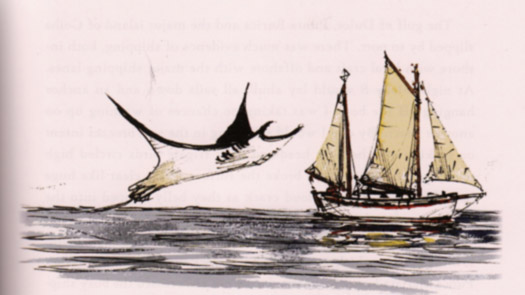
Creatures of the deep – a giant manta ray take flight past Pete Hogan's ketch Molly B, one of his many attractive illustrations for his new book "The Log of the Molly B".
THE JOY OF WORK (when others are doing it)
It was intriguing to note that one of the most popular features at the recent Hamburg Boat Show was a special active exhibition where damaged or worn glassfibre boats were given the complete restoration treatment during the course of the show.
It all sounds rather un-Germanic - you'd think their attitude would be that such things should be done by professionals behind closed doors. And heaven only knows what the front-line exhibitors showing shiny new boats made of the fact that so much attention was being given to scruffy old ones. But it was a runaway success, the DIY brigade loved it and learned much from it, and of course for the ordinary Joes and Josephines who wouldn't dream of doing their own maintenance and repair tasks, there was the eternal fascination of watching work in progress.
Those of us who were lucky enough to be allowed in to the workshop at Collins Barracks when John Kearon and his team were conserving Asgard could only reflect that it was a pity that when the historic old ketch was finally put on display, it would be as a static exhibit. In many ways it was more interesting when the work was in progress, not least when the team of voluntary riggers from Howth, led by Pat Murphy and Neville Maguire, were on the job to provide enough in the way of spars and rigging to give a better impression of what Asgard was like in her heyday.
However, the work has been so well done that even with the old girl now totally at rest and on display, it's a very complete exhibition, encompassing the development of yacht design and building with an insight into a very complex period in Irish history.
With a well-chosen selection of photos, the human interest shines through in unexpected ways. We already knew that Erskine Childers' friend and shipmate, Gordon Shephard, had an easygoing approach to life despite twice being the recipient of the Royal Crusing Club's Chakenge Cup, the world's senior voyaging award. He won it in 1911 and again in 1913, the latter year as skipper of Asgard on a late Autumn voyage from Norway to North Wales, going west of Scotland.
In the Great War, immediately after the gun-running of 1914, he became the youngest Brigadier, on active service with the Royal Flying Corps. He did not survive the war. Yet up in Collins Barracks, he is forever alive, aboard Asgard as she sails along in July 1914 laden to the deckbeams with vintage guns, photographed at the helm wearing what look like an old and not at all stylish cardigan, the very essence of the happy-go-lucky cruising man.
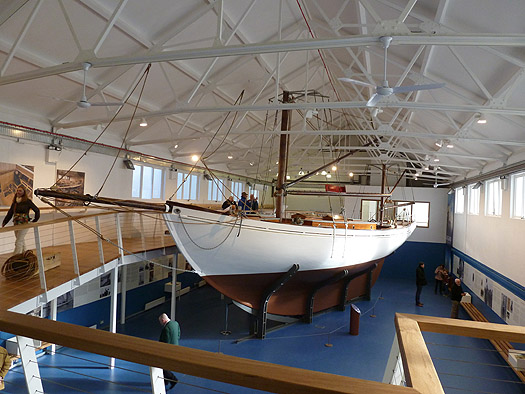
The conserved Asgard on display in the museum at Collins Barracks. The exhibition provides a valuable insight into the cruising yachts of her era, and the human story of those involved in a complex historical episode. Photo: W M Nixon
ISA Chief Sees Bright Future for Irish Sailing
#IRISH SAILING - Irish Sailing Association (ISA) chief executive Harry Hermon took time out from the ISAF annual conference in Dublin this week to talk to Sport for Business about the growth of sailing in Ireland.
“2012 has been in many ways a breakthrough year for the sport,” he said. “We hosted so many major events during the year, from the Volvo Ocean Race finale in Galway to the World Youth Championships on Dublin Bay and of course it was an Olympic year and we had our strongest performance for many years.”
Aside from building on commercial partnerships, Annalise Murphy's near-medal-winning performance at the London Olympics was a boon for the profile of sailing in the public's imagination, and Hermon intends for the ISA to capitalise on this in the years to come, both for the Rio Games in 2016 and beyond.
“20,000 young people are coming through certified courses each year and staying with the sport," he said. "In addition we are reaching out to tens of thousands more through multi-activity camps ‘on the water’ around the coastal and inland waterways that are such an attribute in Ireland.
“We have a sport that enables 18-year-olds to race alongside their grandparents and few can offer such a crossover appeal.”
Sport for Business has much more on the story HERE.
Ainslie, Xu Named World Sailors of the Year in Dublin Ceremony
Eyes were on Dublin last night when two dinghy sailorswere crowned the world's top sailors. Ben Ainslie (GBR) and Lijia Xu (CHN) were named the male and female winners of the 2012 ISAF Rolex World Sailor of the Year Awards at a ceremony held at the Mansion House, Dublin, last night.
Four-time Olympic Gold medallist Ben Ainslie commented, "Winning the ISAF Rolex World Sailor of the Year award is a huge honour, especially for everyone who has helped me. There is a huge team in the background from family, friends, coaches and sponsors who helped make it happen. It is a huge honour to be part of such a group of exceptional sailors who were put forward for this award."
It is the fourth time that Ainslie has been named ISAF Rolex World Sailor of the Year, following titles gained in 1998, 2002 and 2008. Ainslie is the most successful Olympic sailor of all time. The 35-year old's achievement at London 2012 elevated him to five Olympic medals (four gold, one silver), surpassing Rolex Testimonee Paul Elvstrøm (DEN), winner of four gold medals between 1948 and 1960.
Lijia Xu, Laser Radial Gold Medallist at London 2012, expressed her delight at becoming only the second Asian athlete to be crowned ISAF Rolex World Sailor of the Year and spoke of her passion for the sport, "Sailing has given me the chance to chase my dreams and the stage to show my potential. It has provided me with the opportunity to see, feel and explore the world. Sailing leads me to a path of a better life, a life full of vitality, excitement and joyful experiences."
In August, Xu became the first Chinese, and indeed Asian, sailor to win an Olympic Gold medal in a dinghy sailing boat.
Ben Ainslie (GBR) – History Boy
The greatest of his generation. Four Olympic gold medals and now as many ISAF Rolex World Sailor of the Year Awards. Ben Ainslie is the most successful Olympic sailor of all time. The 35-year old's achievement at London 2012 elevated him to five Olympic medals (four gold, one silver), surpassing Rolex Testimonee Paul Elvstrøm (DEN), winner of four gold medals between 1948 and 1960. On receiving the award, Ainslie paid tribute to the team that has supported him, "Winning the ISAF Rolex World Sailor of the Year award is a huge honour, especially for everyone who has helped me. There is a huge team in the background from family, friends, coaches and sponsors who helped make it happen. It is an honour to be part of such a group of exceptional sailors who were put forward for this award."
Ainslie headed into his home Olympics under a colossal weight of expectation. He was given the honour of welcoming the Olympic torch on its arrival in the United Kingdom, and was chosen as the first of 8,000 torchbearers. Fittingly, after making history on the waters off Weymouth, Ainslie was selected as Team GB's flag bearer at the Closing Ceremony. "To take part in a home Olympics was a completely unique experience," reflected Ainslie. "I have never felt quite the same level of expectation but also level of support."
Once competition started, it was another Dane - Jonas Høgh-Christensen - who contrived to stand between Ainslie and his fourth Olympic Gold. Ainslie began the 2012 competition better than any previous Games, but not as well as Christensen. Ainslie needed to react and he used a racecourse incident during the second half of the week to channel his competitive energy. The reigning Olympic champion found a new level, won two of the last four races and went into the decisive medal race needing to beat the relentless Dane but avoid conceding too many points to his other closest rivals. In front of a partisan crowd and following a nail-biting encounter, Ainslie emerged victorious. He cut an exhausted and emotional figure on the finish line. "These Olympics were not that easy for me, sometimes it flows, sometimes you have to fight for it," he admitted. "It was tough fight all the way to the finish. Taking the gold medal in front of a home crowd - I don't think I will ever experience an emotion quite like that again."
Ainslie has been at the top for 20 years, enduring enormous self-sacrifice in his quest for perfection. A pursuit that involves never giving an inch in training sessions and a relentless competition schedule. His remarkable career has seen him claim nine European titles and ten world championships – the first back in 1993. Few sportsmen, in any discipline, have been at the forefront of their profession for such a sustained period.
He has given the sport some of its finest moments including two epic battles with Rolex Testimonee Robert Scheidt (BRA) at the 1996 and 2000 Olympic Games - duels that drew a wider public to sailing.
Driven and passionate, Ainslie is a compelling character whose future in the sport is expected to concentrate on his desire to launch a British America's Cup challenge. As part of his 'apprenticeship' Ainslie is part of Team Oracle under the stewardship of two-time ISAF Rolex World Sailor of the Year Russell Coutts, and alongside the 2010 ISAF Rolex World Sailor, Tom Slingsby.
Ainslie's excellence in the sport has been recognised with this record fourth ISAF Rolex World Sailor of the Year Award following titles gained in 1998, 2002 and 2008. However, Ainslie remains modest about his momentous achievements, "There are a lot of fantastic sailors out there and when you look at someone like Paul Elvstrøm, he revolutionised the sport of sailing in his day and I certainly don't think I can claim to have done that. I am very fortunate to have had the support to do what I have."
Lijia Xu (CHN) – Immense Competitor
The inspirational Lijia Xu etched her name in the history books in August 2012 becoming the first Chinese, and indeed Asian, sailor to win an Olympic Gold medal in a dinghy sailing boat. "I didn't expect to be the winner," admitted Xu. "It is an honour to be named ISAF Rolex World Sailor of the Year and become the first sailor from China to receive this award. I hope this award can inspire more children in China to take up the sport."
Xu triumphed in the Laser Radial, one of the tightest and most dramatic competitions at London 2012. This after the Shanghai-born sailor hardly made an auspicious start to competition, finishing in the top three positions in only one of the first six races. During the second half of the week, Xu's class came to the fore. In a manner reminiscent of her fellow 2012 ISAF Rolex World Sailor of the Year, she showed grit and determination to put herself in pole position for the deciding medal race.
Going into that final race, Xu could not afford to slip up with three rivals all in strong contention. In a winner takes all finalé, the 25-year old Chinese sailor sailed best, winning the race and adding Olympic Gold to the Bronze she claimed in Beijing. Her victory lap following the dramatic medal race was one of the sailing competition's iconic moments. "It was a fantastic medal race that will be remembered forever," said Xu. "On crossing the finishing line I realized not only my own dream but also the whole nation's dream. Many people strived for this gold for so many years and despite all the difficulties and setbacks we conquered it."
Victory in London proved the crowning achievement following an impressive year, where she won three ISAF Sailing World Cup regattas and peaked at the right time after claiming an impressive silver medal during a highly competitive Laser Radial World Championship in May.
A keen swimmer in her youth, Xu's passion for sailing began from the age of 10 when she started Optimist sailing in Shanghai. She took to the sport immediately. By 2001, at the age of 14, she was Girls' Optimist World Champion, a title she reclaimed in 2002. Her story is one of resilience. Xu has battled significant hearing and sight problems and missed out on a place at the Athens Olympics in 2004, when a routine medical examination revealed a tumour in her leg that subsequently required major surgery.
Xu resiliently bounced back and in 2006 won the Laser Radial Women's World Championship. That success, together with the Bronze medal gained at Beijing, on the back of a serious hand injury, propelled Xu onto the international stage. "The most challenging part of my career has been facing injuries. It is important to never give in, never yield," added Xu.
Xu, who was also her nation's flag bearer at the Closing Ceremony of London 2012 is assessing whether to mount a campaign for the 2016 Games in Rio. In the meantime, she is taking time to complete her studies and reflect on the love she has for her sport, "Sailing has given me the chance to chase my dreams and the stage to show my potential. It has provided me with the opportunity to see, feel and explore the world. Sailing leads me to a path of a better life, a life full of vitality, excitement and joyful experiences."
Xu is only the second Asian sailor to be named ISAF Rolex World Sailor of the Year following in the footsteps of female windsurfer Lee Lai Shan (HKG) who won in 1996.
Double Olympic gold medallist and World Sailor of the Year in 2000, Shirley Robertson, hosted the ceremony. The Awards were presented by ISAF President of Honour HM King Constantine and Joël Aeschlimann of Rolex SA. Both winners were presented with a Rolex timepiece and an ISAF Rolex World Sailor of the Year trophy.
A Stellar Supporting Class
In addition to the two winners, the list of nominees for the 2012 ISAF Rolex World Sailor of the Year Award included:
Male
Mathew Belcher & Malcolm Page (AUS) – Men's 470 - London 2012 Olympic Gold Medallists, 2011 and 2012 World Champions & 2011-12 ISAF Sailing World Cup Champions
Nathan Outteridge & Iain Jensen (AUS) – 49er - London 2012 Olympic Gold Medallists & 2011 and 2012 World Champions
Loïck Peyron (FRA) – Outright Around the World Record
Tom Slingsby (AUS) – Laser - London 2012 Olympic Gold Medallist & 2011 and 2012 World Champion
Female
Tamara Echegoyen, Angela Pumariega and Sofía Toro (ESP) – Women's Match Racing - London 2012 Olympic Gold Medallists
Helena Lucas (GBR) – 2.4mR - London 2012 Paralympic Gold Medallist and 2011-12 ISAF Sailing World Cup Champion
Saskia Sills (GBR) – RS:X - ISAF Youth Sailing World Champion & European Youth Champion
With the exception of Loïck Peyron all of the nominees attended the Awards Ceremony, celebrating a year of outstanding achievement.
ISAF Rolex World Sailor of the Year Awards
The winners of the ISAF Rolex World Sailor of the Year Awards are decided by vote by the over 130 Member National Authorities of ISAF following a worldwide selection process that begins with an open invitation for nominations. Two awards, one for a female sailor/crew and one for a male sailor/crew, are presented to the individuals who are deemed to have most distinguished themselves during the qualifying period from 1 September 2011 to 31 August 2012.
Past recipients of the Awards – which were launched in 1994 – have been drawn from the diverse disciplines of the sport: Olympic dinghy and keelboats, single-handed ocean racing, transatlantic record breaking, match-racing, America's Cup and windsurfing are all represented. In addition to the magnificent ISAF Rolex World Sailor of the Year Trophy, each winner is presented with a Rolex timepiece.
ISAF Rolex World Sailors of the Year for 2012 Announced Tonight
#ISAF - In just a few hours the International Sailing Federation (ISAF) and Rolex will announce the 2012 ISAF Rolex World Sailors of the Year in Dublin.
The award ceremony will take place during a dinner hosted at the historic Mansion House in the heart of the capital, and will be attended by many of the world’s top sailors and delegates to the ISAF Annual Conference taking place in Dun Laoghaire.
This year's winners as always are selected by the ISAF Member National Authorities (MNAs), the national governing bodies for sailing around the world, who have been invited to vote for one male and one female nominee they believe most deserves the award for their efforts during the nomination period.
This year there are five male and four female nominees who have been shortlisted for the ISAF Rolex World Sailor of the Year Awards based on their achievements during the qualifying period of 1 September 2011 to 31 August 2012.
HM King Constantine, ISAF President of Honour, will announce the winners, each of whom will be presented with the prestigious ISAF Rolex World Sailor of the Year trophy and a distinctive Rolex timepiece.
The 2012 nominees are:
Male
- Ben Ainslie (GBR) - Finn - London 2012 Olympic Gold Medallist & 2012 World Champion
- Mathew Belcher & Malcolm Page (AUS) - Men's 470 - London 2012 Olympic Gold Medallists, 2011 and 2012 World Champions & 2011-2012 ISAF Sailing World Cup Champions
- Nathan Outteridge and Iain Jensen (AUS) - 49er - London 2012 Olympic Gold Medallists & 2011 and 2012 World Champions
- Loïck Peyron (FRA) - Outright Around the World Record
- Tom Slingsby (AUS) - Laser - London 2012 Olympic Gold Medallist & 2011 and 2012 World Champion
Female
- Támara Echegoyen, Ángela Pumariega and Sofía Toro (ESP) - Women's Match Racing - London 2012 Olympic Gold Medallists
- Helena Lucas (GBR) - 2.4mR - London 2012 Paralympic Gold Medallist & 2011-12 ISAF Sailing World Cup Champion
- Saskia Sills (GBR) - RS:X - ISAF Youth Sailing World Champion & European Youth Champion
- Lijia Xu (CHN) - Laser Radial - London 2012 Olympic Gold Medallist
Find out more HERE about the nominated sailors and their achievements.
Dun Laoghaire Prepares for ISAF World Sailing Conference
#isaf – The small print for world sailing comes under scrutiny this November in Dun Laoghaire when the town and four yacht clubs welcome back the world sailing body back to the Irish east coast for the second time this year. The world youth sailing champs having sailed on Dublin Bay in July.
The agendas, supporting papers and submissions which will be discussed at the 2012 ISAF Annual Conference in Dun Laoghaire have been published online on the ISAF Meetings microsite.
The 2012 ISAF Annual Conference takes place from 1-11 November 2012 and will bring together the ISAF Council, Committees and Commissions along with other leading figures from the sailing world to debate, discuss and decide upon the key issues in the sailing world.
Over 100 Submissions - proposals to either change an existing ISAF policy or introduce a new policy in the sport - have been received from ISAF Member National Authorities (MNAs), ISAF Classes, Committee Chairmen and the Executive Committee covering many aspects of the sport. These will be debated alongside the other items addressed on each Committee's Agenda at the meetings in November.
For ease, there are various options by which you can download papers - by a specific Committee, by Submission, by Agenda, by Supporting Paper - and the papers can be downloaded individually or as a bulk download, which is provided by a zip file download. The meeting papers are available to access here.
On the ISAF Meetings microsite, you can find more details on the 2012 Annual Conference and General Assembly. There's also a simple guide to ISAF's decision-making process and a full database of past meeting papers.
#KITESURFING - The International Sailing Federation (ISAF) has responded to the legal challenge from the International RS:X Class Association to its decision to cut Olympic windsurfing from the Rio games in 2016 in favour of kitesurfing.
As previously reported on Afloat.ie, kitesurfing was given two medal events at the next Olympics following a mid-term meeting of the ISAF Council in Italy nearly three months ago.
In a statement, the ISAF said it "intends to fully defend the decision of the ISAF Council, which was made in accordance with the ISAF regulations and the defined decision making processes of the ISAF."
Sailing's world governing body said it was "extremely disappointed that this course of action has been taken" - rather than the "normal submission process" to request the council to reconsider its decision at the ISAF AGM in November - "not least because responding to legal claims will incur substantial and unnecessary legal costs for ISAF and for the class itself."
There has been some controversy surrounding the decision to include kitesurfing over windsurfing at the Rio games after claims that the council vote was married by "language difficulties" among the Spanish delegate.
Spain, a long-time windsurfing stalwart, surprised many by joining the 19-17 vote in favour of the newer discipline, which was supported by Ireland's John Crebbin.
Whither the Weather with Silver in the Bag
#isafyw12 – Sailing folk are getting worried about this summer's weather in northwest Europe. There's a real chance that it might be going to improve, particularly in northern France and southern England. And that might mean gentle conditions spreading in over the Olympic sailing venue at Weymouth on the Dorset coast.
Normally, of course, we would wish Weymouth all the very best in the matter of summer weather. In the heart of the place is a nice little river port where many an Irish sailor has been glad to spend a night or two for a spot of R & R. It has a bustling and attractive quayside which looks all the better for some sunshine. Just enough breeze to waft away the aroma of fish and chips, and Bob's your uncle.
But these are not normal times. A week hence, they'll be gearing up for the opening ceremony of the Sailing Olympiad at the Weymouth and Portland centre. Back in June, they staged the huge Skandia Sail for Gold Regatta there, as near as makes no difference to being an Olympic dress rehearsal. But the weather wasn't impressed – it was absolutely foul, with strong winds, plus enough rain for a year. Yet the Irish contingent loved it, with the Star crew of Peter O'Leary of Crosshaven and David Burrows of Malahide winning Gold, while Laser Women's Radial sailor Annalise Murphy of Dun Laoghaire took the Bronze.
We like to think we can be as good as the next crew in racing in light airs and sunshine, but there was no mistaking the way in which the Irish contingent revelled in the Dorset downpour. 'Tis only a shower, they merrily quipped, and went out and notched yet another win. Meanwhile other contenders – particularly those from sunnier climes – complained endlessly. And even the British crews (for it was their weather, after all) solemnly announced that they were carefully pacing themselves, as they didn't want to peak too early.
Be that as it may, the Irish squad are in the weird situation that their supporters – which is all of us – are getting worried that if things get better, then they'll actually be getting worse. Better on the weather front may mean worse on the results front. But you never know. The weird weather having moved centre stage in recent weeks, we're now aware that one line of thought is that the level of sunspot activity has a lot to do with disturbed global weather patterns.
For most of us in Ireland, if we could only see the sun now and again, we'd be perfectly happy for it to display signs of advanced acne. But apparently last week the sun became hyperactive again, and there were sunspots galore on July 12th. The date being what it was, on the Emerald Isle we could be excused for overlooking this. But the top sunspot honchos tell us that normal predictions are now out the window, and late July and early August could be every bit as awful as June.
It'll all be slightly clearer in a week's time. The first classes will be racing from July 29th onwards, and the final medal races and victory ceremonies – for the Finns and the Stars – will be on August 5th, with the Laser Radials a day later.
Meanwhile, watch those sunspots. But just for now, it's taking a while for it to sink in that Finn Lynch collected his silver yesterday at the ISAF Youth Worlds, aged just 16. Because the age span of 16-19 is so narrow, the rest of sailing tends to see the Youth Worlds as being something rather ephemeral, gone in a trice. But when you're just 16, the years stretching ahead to 19 seem to be for ever, and heaven only knows what young Lynch will be achieving at the end of the time he is still qualified to sail in the Youth championship.
It was fascinating to note as the championship progressed that the true origins of our young stars became clarified. The Dun Laoghaire machine tends to hoover up talent from all around the country as it begins to manifest itself. Thus when the Irish lineup was announced, it seemed to be wall-to-wall Dun Laoghaire and Crosshaven. But those of us who savour the sheer variety of places where people sail in Ireland were happy to note that Sophie Murphy's Strangford Lough connections – Quoile YC to be precise – were getting at least equal billing with her adopted base at the Royal St George. And though Finn Lynch may be promoted as part of the National YC lineup of talent, we trust there was celebration last night in Blessington for their new star from the lake.
W M Nixon's sailing column is in the Irish Independent on Saturdays
Dublin Bay Delivers Tricky ISAF Youth Worlds Finale
#isafyw12 – Cool heads and steely nerves were among the vital attributes required to achieve ultimate success as the 2012 Four Star Pizza ISAF Youth World Sailing Championships finished on Dublin Bay in Ireland.
Across the eight different classes the finale was marked by light, conflicting breezes with at least as many title upsets unfolding through the day as there were expected winning scenarios playing out on cue.
In the evenly balanced 420 Boys class a hard earned final race victory by Barcelona's twin brothers David and Alex Charles won them the title, complementing the gold medal in the 29er skiff class which was secured on Thursday by club mates Carlos Robles and Florian Trittel.
The Charles brothers went into the last race in third, considering themselves outsiders for the gold medal, but they were able to capitalise on their own great start whilst their nearest rivals, the French pair which have lead most of the regatta – Guillaume Pirouelle and Valentin Sipan - tussled in the depth of the fleet with the Netherlands Pieter Goedhart and Lars Van Steklenborg
"We have been consistent in very difficult conditions and that has made the difference." Concluded Alex Charles.
While the two pairs of Spanish gold medallists celebrated together, all good friends who started out in Optimists together at the same club some 20kms up the coast from the Catalan capital, there was a tough measure of heartache for the USA's Mitchell Kiss in the Laser Radial Boys class.
Just as the French duo had been arithmetical favourites to win the 420, so Kiss had this morning looked poised to deliver in the Boys Radial fleet.
But, with a BFD disqualification as his discard result, Kiss ultimately fell prey to Australia's Mark Spearman who held his nerve and corralled the class leader to the back of the fleet on the first leg.
There was no way of breaking free for the unfortunate American sailor who crossed the line 52nd with the Perth WA sailor one place ahead.
That being Spearman's discard race he secured Australia's only gold medal of the championships.
"My worse race was 17th so I was always going out to do what I did. We stayed on a knock for ages and when we tacked back and from there we were last and second last.
It is part of racing to do that. I was able to do that because I had sailed consistently in the rest of the regatta." Said Spearman, "It is an inspiration to see the form of Tom Slingsby and Tom Burton at the moment, but they are people I want to beat in the future. You have to get to that level. It is a long road but this is a stepping stone. Everyone else has had good and bad races, I have been consistent, sailing safely with less risk, starting one third from either end and tacking on the right shifts."
The most emotional moments of the regatta came fittingly when Dublin's 16 year old Finn Lynch was carried shoulder high from his native waters, still in his Laser Radial, after sailing to silver, the best ever ISAF Youth Sailing World Championships finish for the host nation which has delivered a truly memorable, perfectly executed regatta.
In the Laser Radial girls class Gothenburg's Julia Carlsson was the absolute model of consistency, only one finishing outside the top 10. The quietly spoken, cool Swede finished with a 1,2,2,3 to wrap up her nation's first ISAF Youth Sailing World Championships medal since 2006.
"I sailed the best I ever sailed when I needed to. I was really nervous all the way through the race today. Tactically I feel like I have sailed well." Carlsson said.
The Great Britain team's haul of two gold medals and one bronze contribute substantially to their wresting the Nations Trophy, breaking the French monopoly on the team award for the first time since 2008.
Whilst Britain's SL16 catamaran winners Rupert White and Tom Britz had done enough by Thursday to win overall, in the RS:X Girls their compatriot Saskia Sills did what she needed to today to clinch her first world title at just her second ever international RS:X race series.
After bronze at the RS:X Youth Europeans earlier in the month, Sills came back from a nervous wobble in the penultimate race of the series, to win the title with a second place, finishing just behind Israel's silver medal winner Naomi Cohen.
" I am so chuffed, I can't believe it." Smiled Sills who only started in the RS:X late last year, " I have not been on the water as much as I would have liked for the last three months because I have had exams, and so I have just been working hard in the gym. I did not expect to even medal. My first RS:X international event was only last week."
" We have had videos from the Olympic team, Nick Dempsey and Paul Goodison, and all the support team around us have been encouraging us to start this Olympic summer with medals and here we are."
Sills has been largely dominant in the girls' RS:X fleet with four wins and three second places in her scoreline but Italian Mattia Camboni was relatively unknown to Korea's double Youth Worlds medallist Wonwoo Cho.
Though the Italian sailor returned ashore with a silver, it was a bittersweet result for him.
He needed only to beat the Korean today to steal the overall title from the RS:X sailor who has a gold from Zadar, Croatia last year and silver from 2010 in Istanbul.
Camboni was duly on target to do just that, with Cho well behind, until the first attempt at a race was abandoned due to a big windshift.
When Race 12 ran its full course, Cho finished third while Camboni could only manage fifth after a bad start.
"The first race was so shifty I went the wrong way and was very bad. I thought I had lost the title. But it was cancelled. But I cleared my mind. My mind is strong and I used my anger to get a good start. The second race was much lighter and that is what I like. This is the most difficult, more difficult than last year. I did not know the Italian guy but he is a great sailor. I can't believe I have won again." Said Cho.
The Italian girls Ilana Paternoster and Benedetta Disale, from Genoa, held on to their consistent scoreline in the difficult conditions to land the Girls 420 title. Australia's Carrie Smith and Ella Clark struggled in the early part of the difficult final race and took silver ahead of Britain's Annabel Vose and Kirstie Irwin in bronze.
"We cannot believe we are world champions, maybe this evening or tomorrow it will sink in. We never even expected to get in the top five, far less win. But we have worked hard for it. We could look back and see where the Australians were and knew we could do it." Said Paternoster.
ISAF Youth Worlds 2012
FINAL OVERALL RESULTS
Laser Radial (Boys)
1st - Mark Spearman (AUS) 125pts 2nd - Finn Lynch (IRL) 134pts 3rd - Herman Tomasgaard (NOR) 145pts
Laser Radial (Girls)
1st - Julia Carlasson (SWE) 58pts 2nd - Line Flemhost (NOR) 76pts 3rd- Cecilia Zorzi (ITA) 99pts
420 (Boys)
1st – David Charles/Alex Charles(ESP) 61pts 2nd - Guillaume Pirouelle/Valentin Sipan (FRA) 65pts 3rd - Pieter Goedhart/Lars Van Stekelenborg (NED) 66pts
420 (Girls)
1st - Ilaria Paternoster/Benedetta Disalle (ITA) 44pts 2nd - Carrie Smith/Ella Clark (AUS) 51pts 3rd- Annabel Vose/Kirstie Urwin (GBR) 57pts
29ers
1st - Carlos Robles/Florian Trittel (ESP) 21pts 2nd – Lucal Rual/Thomas Biton (FRA) 38pts 3rd – Klaus Lange/Mateo Majdalani(ARG) 47pts
SL16 Catamaran
1st –Rupert White/Tom Britz (GBR) 20pts 2nd - Paul Darmanin/Lucy Copeland (AUS) 40pts 3rd - Martin Manzoil Lowy/Kim Vidal (BRA) 42pts.
RSX Boys
1st – Wonwood Cho (KOR) 32pts 2nd- Matta Camboni ( ITA) 34pts 3rd - Maxime Labat (FRA) 67pts
RSX Girls
1st - Saskia Sills (GBR) 30pts 2nd - Naomi Cohen (ISR) 42pts 3rd - Veronic Fanciulli (ITA) 58pts
Nation's Medals for Four Star Pizza ISAF Youth Sailing World Championship 2012
Spain: Gold in the 29ers class; gold in the 420 boys class;
Great Britain: Bronze in the 420 girls class; gold in the SL16 class; gold in the RSX girls class.
France: Silver in the 420 boys class; silver in the 29er class; bronze in the RSX boys class.
The Netherlands: Bronze in the 420 boys class.
Italy: Gold in the 420 girls class; bronze in the laser radial girls class; bronze in the RSX girls class; silver in the RSX boys class.
Austrailia: Silver in the 420 girls class; silver in the SL16 class; gold in the laser radial boys class.
Argentina: Bronze in the 29er class.
Brazil: Bronze in the SL16 class.
Ireland: Silver in the boys laser radial class.
Norway: Bronze in the laser radial boys class; silver in the laser radial girls class
Sweden: Gold in the laser radial girls class.
Israel: Silver in the RSX girls class.
Korea: Gold in the RSX boys class.




























